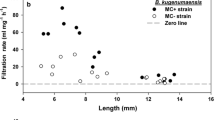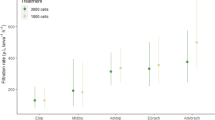Abstract
Filtration and ingestion rates of Branchionus plicatilis, fed with four separate algae, have been studied in a wide range (up to 200 µg · ml−1) of food concentrations, commonly used in mass culture. With Nannochloris oculata, Nannochloris maculata and Nannochloropsis oculata filtration rates with increasing cell concentration at low and moderate food levels, and remain constant at higher concentrations. Ingestion rates increase with cell density at very low concentrations, remain constant at moderate densities, and increase again at higher food levels. The results are different with rotifers fed on Nannochloropsis gaditana since both filtration and ingestion rates decrease at cell concentrations above 15 × 106 cells · ml−1.
Similar content being viewed by others
References
Bogdan, K. G. & J. J. Gilbert, 1982. Seasonal patterns of feeding by natural populations of Keratella, Polyarthra and Bosmina: Clearance rates, selectivities and contributions to community grazing. Limnol. Oceanogr. 27: 918–934.
Capuzzo, J. M., 1979. The effects of halogen toxicants on survival, feeding and egg production of the rotifer Brachionus plicatilis. Estuar. coast. mar. sci. 8: 307–316.
Chotiyaputa, C. & K. Hirayama, 1978. Food selectivity of the rotifer Brachionus plicatilis feeding on phytoplankton. Mar. Biol. 45: 105–111.
Doohan, M., 1973. An energy budget for adult Brachionus plicatilis Muller (Rotatoria). Oecologia 13: 351–362.
Droop, M. R. & J. M. Scott, 1978. Steady-state energetics of a planktonic herbivore. J. mar. biol. Ass. U. K. 58: 749–772.
Dumont, H. J., 1977. Biotic factors in the population dynamics of rotifers. Arch. Hydrobiol. 8: 98–122.
Gatesoupe, F. J. & J. H. Robin, 1981. Commercial single-cell proteins either as sole food source or in formulated diets for intensive and continuous production of rotifers (Brachionus plicatilis). Aquaculture 25: 1–15.
Hirayama, K., K. Takagi & H. Kimura, 1979. Nutritional effects of eight species of marine phytoplankton on population growth of the rotifer Brachiones plicatilis. Bull. jap. Soc. Scient. Fish. 54: 11–16.
Lam, R. K. & B. W. Frost, 1976. Model of copepod filtering response to changes in size and concentration of food. Limnol. Oceanogr. 21: 490–500.
Lubián, L. M., 1979. Factores que afectan al crecimiento en cultivo del alga planctónica marina Nannochloris sp. Inf. Técn. Inst. Inv. Pesq. 67.
Lubián, L. M., 1982. Ultraestructura y pigmentos de algunas Chlorophyceae y Eustigmatophyceae planctónicas de morfología similar. Collectanea Botanica 13: 873–880.
Lund, J. W. G., C. Kipling & E. D. Le Cren, 1958. The inverted microscope method of estimating algal number and statistical basis of estimations by counting. Hydrobiologia 11: 143–170.
Pourriot, R., 1973. Rapports entre la température, la taille des adultes, la longeur des oeufs et la taux de développement embryonnaire chez Brachionus calyciflorus Pallas (Rotifére). Ann. Hydrobiol. 4:103–115.
Pourriot, R., 1977. Food and feeding habits of Rotifera. Arch. Hydrobiol. 8: 243–260.
Pourriot, R. & C. Rougier, 1979. Influences conjuguées du groupement et de la qualité de la nourriture sur la reproduction de Brachionus plicatilis O. F. Müller (Rotifére). Neth. J. Zool. 29: 242–264.
Schlosser, H. J. & K. Anger, 1982. The significance of some methodological effects on filtration and ingestion rates of the rotifer Brachionus plicatilis. Helgoländer Meeresunters. 35: 215–225.
Serra, M. & M. R. Miracle, 1983. Biometric analysis of Brachionus plicatilis ecotypes from spanish lagoons. Hydrobiologia 104: 279–291.
Snell, T. W. & K. Carrillo, 1984. Body size variation among strains of the rotifer Brachionus plicatilis. Aquaculture 37: 359–367.
Starkweather, P. L., 1980. Aspects of the feeding behavior and trophic ecology of suspension-feeding rotifers. Hydrobiologia 73: 63–72.
Theilacker, G. H. & M. F. McMaster, 1971. Mass culture of the rotifer Brachionus plicatilis and its evaluation as food for larval anchovies. Mar. Biol. 10: 183–188.
Yúfera, M., 1982. Morphometric characterization of a smallsized strain of Brachionus plicatilis in culture. Aquaculture 27: 55–61.
Yúfera, M., E. Pascual, 1980. Estudio del rotífero del rotifero Brachionus plicatilis O. F. Muller alimentados con levadura de panificación. Inv. Pesq. 44: 361–368.
Yúfera, M. & E. Pascual, 1984. Influencia de la dieta sobre la puesta del rotifero Brachionus plicatilis en cultivo. Inv. Pesq. (in press).
Yúfera, M., L. M. Lubián & E. Pascual. 1983. Efecto de cuatro algas marinas sobre el crecimiento poblacional de dos cepas de Brachionus plicatilis (Rotífera: Brachionidae) en cultivo. Inv. Pesq. 47: 325–337.
Author information
Authors and Affiliations
Rights and permissions
About this article
Cite this article
Yúfera, M., Pascual, E. Effects of algal food concentration on feeding and ingestion rates of Brachionus plicatilis in mass culture. Hydrobiologia 122, 181–187 (1985). https://doi.org/10.1007/BF00032106
Received:
Revised:
Accepted:
Issue Date:
DOI: https://doi.org/10.1007/BF00032106




